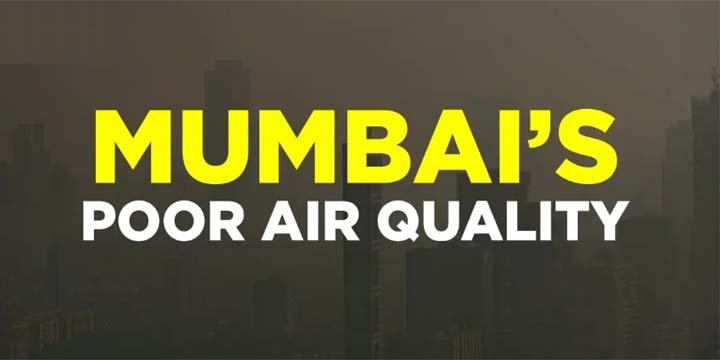MUMBAI AIR POLLUTION
CONTEXT:
- Recently, Mumbai’s air quality has deteriorated with the Air Quality Index (AQI) being above 200 (poor) at several places in the city in the past few days.
MORE ABOUT THE NEWS:
- The air quality index in Mumbai, which was in the “good category” earlier this month, has now been ranging between the “moderate” and “poor” categories.
- Air quality in the city worsened nearly two weeks after the end of the monsoon.
CAUSES OF MUMBAI’S AIR POLLUTION:
- As several reasons are being associated with the current situation of Mumbai’s air quality.
- The primary cause is believed to be the dust arising from construction sites.
- Other causes being climate change; road dust and its displacement; usage of unclean fuels in restaurants, dhabas, bakeries and roadside eateries; open burning of solid waste and garbage; and the industries that include those using Ready Mix Concrete (RMC) plants and casting yard plants.
- The dip in the periodic cooling of the sea surface leads to a defers the strong wind reversal from across the sea, keeping the pollutants hanging in the lower atmosphere for longer period.
- Another cause of pollution in the city is found to be the displacement of dust particles from roads and vehicles carrying construction debris.
- Unclean kitchens can also produce nitrogen di-oxide, carbon mono-oxide and formaldehyde in harmful concentrations.
- Open burning of solid waste and garbage and use of Ready Mix Concrete (RMC) plants and casting yard plants are among other reasons for Mumbai’s poorer air quality.
- A cyclone from the Middle East delivered dust and smog to northern Maharashtra, Gujarat, and Rajasthan last month.
PRECAUTIONARY MEASURES FOR RESIDENTS:
- Residents of Mumbai have been urged by SAFAR to avoid going outside in the early mornings and late at night.
- All outside physical activity should be avoided by sensitive or susceptible populations, and they should be moved inside whenever possible.
- Asthmatics should carry relief medication with them at all times. When they go outside, they should put on N-95 or P-100 masks.
- To the greatest extent feasible, doors and windows should be kept shut.
- And rather than vacuuming, wet mopping should be preferred.
STEPS TAKEN TO IMPROVE AIR QUALITY:
- The Mumbai civic body — Brihanmumbai Municipal Corporation (BMC) — has taken several steps to improve the city’s air quality.
- To control dust, mist machines have been installed at various locations, including Worli Sea Face, Haji Ali, Peddar Road, Swarajya Bhoomi (Girgaon Chowpatty), Nariman Point, Fashion Street, Badhwar Park, and the World Trade Center.
- Various measures like compulsory use of 35-feet high iron sheet enclosures around construction sites and covering under-construction buildings with green cloth or jute sheets on all sides.
- The civic body is also going to operate anti-smog guns on 50 to 60 major roads.
- Sprinkler systems should be provided at all construction sites within 15 days.
POTENTIAL SOLUTIONS:
- More pollution under control (PUC) centres must inspect automobiles every six to seven months.
- Industries, with the power sector contributing to 71 percent of Mumbai’s greenhouse gas emissions, should also make the shift to cleaner fuel by phasing out older powerplants, and treating their emissions as per standards laid down by the Centre.
- There should be stringent enforcement of the Construction & Demolition Waste management Rules, 2016, which mandates a safe and effective construction waste disposal system.
- Authorities must create a plan that outlines essential wards with high levels of particulate matter in the air, as well as garbage segregation, transportation, and recycling that is environmentally beneficial.
WAY FORWARD:
- Air quality monitoring needs to become robust and regular, with real-time updates about the critical air pockets and sources of pollution along with health information.
- Data dissemination should be quick, sorted, combed through and effective so that analysis becomes easier for mitigation and policymaking.
SYLLABUS: MAINS, GS-3, ENVIRONMENT
SOURCE: ORF, THE HINDU




